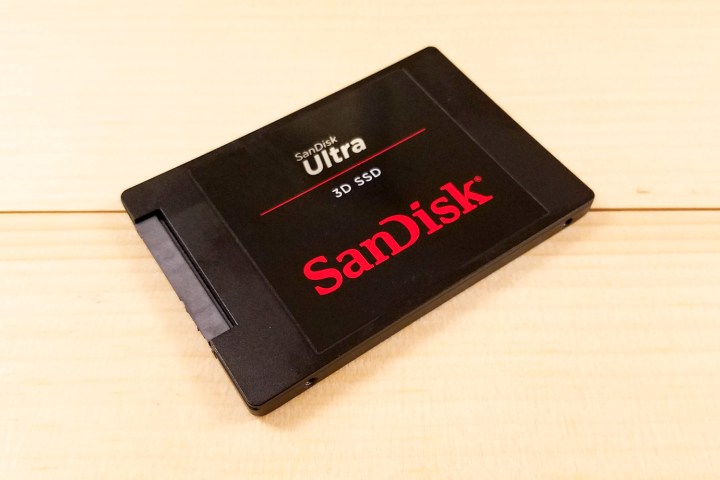Western Digital recently introduced two solid state drives based on its “3D” memory technology for storage. Both are actually identical, with the WD Blue version targeting system builders, resellers, and do-it-yourself enthusiasts, while the SanDisk Ultra model serves mainstream customers, creative individuals, and PC gamers looking to upgrade. In this WD Blue 3D NAND SATA SSD and SanDisk Ultra 3D SSD review, we’re going to examine both, and see if they’re a good choice for giving new life to an older PC.
What exactly is 3D NAND memory?
WD’s headline feature in this pair of drives is the memory technology itself. The typical NAND-based storage device relies on memory cells that are horizontally spread out, like “buildings” in a condensed city. The problem is that while technology can make the buildings smaller and higher (up to four “floors”), they will eventually reach a physical limit.
Instead of spreading storage cells horizontally, 3D NAND used in these two new SSDs stacks them like a skyscraper up to 64 floors high. This design not only increases capacity by expanding upwards, but data travels faster to and from memory cells using an “elevator,” rather than having to travel across buildings.
One platform, two solutions
For our testing, Western Digital sent the WD Blue (WDS100T2B0A-00SM50) and SanDisk Ultra (SDSSDH31000G) 2.5-inch 1TB models that connect to a SATA port. The company said it chose a SATA connection instead of supporting the faster PCI Express interface because SATA is the more commonly used storage connector. It’s been around for a long time, and because of that, Western Digital wanted to offer its 3D NAND technology to a wide, mainstream audience.
Picking up the SSDs feel like handling a credit card (or cracker, if they’re the M.2 type). The 2.5-inch SSDs offered by Western Digital are extremely light too, weighing less than an ounce and a half. But they’re also highly durable outside and within despite their thin and light form factor. And because they rely on 3D NAND technology, Western Digital says the drives should last for a long time.
According to the company, these two SSDs will still be in working order long after they’re obsolete. If you’re managing 20GB of data per day, failure will likely arrive in 56 years. PC owners tossing around 80GB of data per day may see problems in roughly 14 years. Can you say the same about a mechanical hard drive? Nope.
3D NAND sounds fancy – but is it faster?
The packaging states that both models have a maximum read speed of 560MB per second, and a maximum write speed of 530MB per second. Because both are based on the same platform, customers shouldn’t see any difference in speed between the two. Western Digital says that if there is a difference, it’s only due to the manufacturing process.
Here’s the machine we used to test the two SSDs:
| Processor: | Intel Core i7-4790K |
| Motherboard: | Gigabyte GA-Z97X-UD5H |
| System memory: | 8GB DDR3 @ 1,600MHz |
| Graphics card: | Nvidia GeForce GTX 960 |
| Boot storage: | Samsung SSD 840 Pro Series (512GB) |
| Operating system: | Windows 10 Insider Preview Build 16241 |
Now here are the results of the two SSDs:
|
Capacity |
Sequential Write |
Sequential Read |
|
| WD Blue (WDS100T2B0A-00SM50) |
1TB |
540MB/s |
511MB/s |
| SanDisk Ultra (SDSSDH31000G) |
1TB |
539MB/s |
510MB/s |
Note that we typically run the same benchmark three times and then generate an average. But in this case, we ran the benchmarks four times for each SSD, with the results remaining consistent across the board, requiring no averaging. They’re both rather close to the maximum speed of the SATA connection they use, too. The 3D NAND used here might be capable of more, but the limitations of SATA hold it back.
To gain some perspective of how the drives compare to older models, we tested the Samsung SSD 840 Pro Series model already installed in our aging test bed, just to see if Western Digital’s solution made it obsolete. Samsung’s SSD managed an even 537MB per second read and 519MB per second write speeds, indicating that now isn’t the time to swap it out for a better model. For the record, Samsung’s SSD does not have 3D NAND technology.
Bringing “pro” speeds to mainstream PC owners
Based on these results, the use of 3D NAND technology doesn’t necessarily mean insanely fast speed in the case of the WD Blue and SanDisk Ultra units we tested. The emphasis, it seems, is providing a product with a high endurance, high capacity, and low power draw — just 60 milliwatts average active power. If anything, Western Digital is now providing mainstream storage solutions that offer speeds that were thought extreme just a few years back.
Here are the capacities and pricing based on the SanDisk Ultra model listed on Amazon:
These prices aren’t the most affordable, but they’re close. The 250GB drive is a good starting point, and the 1TB drive would be a great pick for a desktop’s main system drive. Then there’s the 2TB drive. While that capacity is not unheard of, the $550 tag on Western Digital’s offering will make it among the most affordable around.
We can’t say the WD Blue and SanDisk Ultra with 3D NAND technology are must-have drives. They compete directly with similar drives like the Crucial MX300 series and Mushkin Enhanced Reactor series. These drives are priced similarly, and should offer similar performance. What you choose is likely a matter of what’s on sale when you buy – but if the WD Blue or SanDisk Ultra drives show up with attractive prices, they’re worthwhile.






